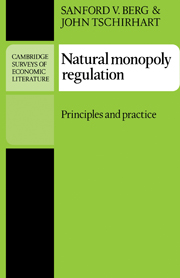Book contents
- Frontmatter
- Contents
- Preface
- 1 Introduction to regulatory economics
- Part I Optimal pricing and investment for natural monopolies
- Part II Natural monopoly regulation in practice
- 8 Regulation in practice: Why and how are firms regulated?
- 9 Models of regulatory constraints
- 10 Technological change under regulation
- 11 Partial regulation, deregulation, and diversification
- 12 Alternatives to traditional regulation
- References
- Author index
- Subject index
9 - Models of regulatory constraints
Published online by Cambridge University Press: 06 November 2009
- Frontmatter
- Contents
- Preface
- 1 Introduction to regulatory economics
- Part I Optimal pricing and investment for natural monopolies
- Part II Natural monopoly regulation in practice
- 8 Regulation in practice: Why and how are firms regulated?
- 9 Models of regulatory constraints
- 10 Technological change under regulation
- 11 Partial regulation, deregulation, and diversification
- 12 Alternatives to traditional regulation
- References
- Author index
- Subject index
Summary
A disproportionately large share of the literature on regulation has involved models of regulatory constraints on a firm's choice set, in particular, models of the rate-of-return constraint. Many theoretical and empirical studies have examined how regulatory instruments in the form of constraints on profits, rates of return, operating ratios, and so on, might affect a firm's choices regarding outputs, factors of production, and, to a lesser extent, prices. This chapter reviews the major results emerging from the literature and points out where additional work is needed. Additional work is important because, for the most part, the literature on regulatory constraint has not crossed over into other topics, such as price structures, sustainability issues, and the expansion of regulated firms into unregulated markets.
Also absent from this literature is an analysis of why one particular regulatory instrument is chosen over another. For instance, why do some regulatory agencies use a rate-of-return constraint and others use an operating ratio as a measure of restricting firm profit? The informational approach discussed in Chapter 8 offers some insights here, but this area is largely untouched. Examining the issues will mean exploring the links among several factors: why regulation is adopted in the first place, what types of instruments are used, and how the instruments affect industry performance. Future research should pro-vide a better understanding of how the demand for regulation and the behavior of regulators (see Chapter 8) give rise to specific instruments and lead to particular outcomes (Chapters 9–11).
The first three sections of this chapter cover the rate-of-return constraint – the issue that dominates the literature on regulatory constraints.
- Type
- Chapter
- Information
- Natural Monopoly RegulationPrinciples and Practice, pp. 323 - 384Publisher: Cambridge University PressPrint publication year: 1989



